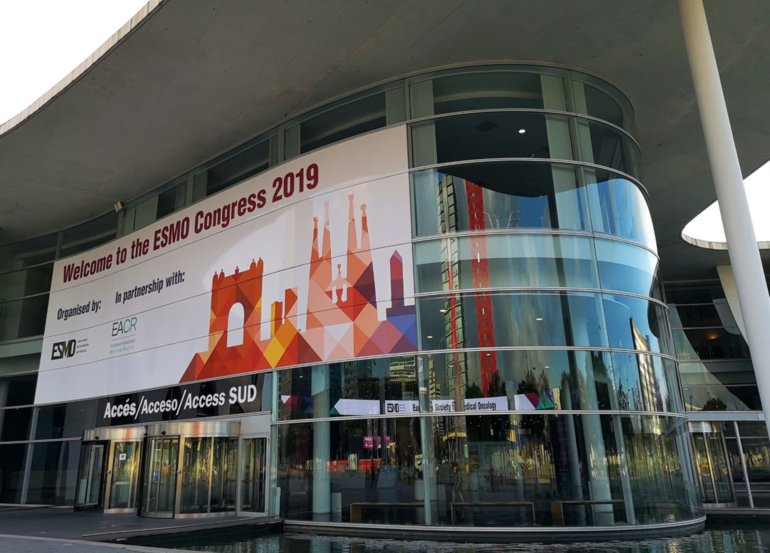Results from the phase II NEOLAP study presented at ESMO 2019
"Patients with locally advanced pancreatic cancer must be treated with combination chemotherapy and, until proven otherwise, valid options are FOLFIRINOX (fluorouracil, leucovorin, irinotecan, oxaliplatin) and nab-paclitaxel plus gemcitabine (nab-PG). The latter followed by FOLFIRINOX is an alternative option, especially in patients who are not definite candidates for FOLFIRINOX,” says Prof. Per Pfeiffer from Odense University Hospital, Denmark, commenting on results from the phase II NEOLAP study (Abstract 671O) that will be presented in today’s ‘Proffered Paper 1 – Gastrointestinal tumours, non-colorectal’ session (14.00 – 15.30, Madrid Auditorium [Hall 2]).This is the first prospective, randomised trial investigating the addition of FOLFIRINOX to two cycles of neoadjuvant nab-PG for locally advanced non-resectable pancreatic adenocarcinoma. In the NEOLAP study, nab-PG followed by FOLFIRINOX was associated with a numerically higher rate of conversion (45.0% versus 30.6%) and longer median overall survival (25.5 versus 17.2 months) compared with nab-PG, although the improvements were not statistically significant.
In the ‘real-life’ setting of the French cohort from AGEO (Association des Gastro-Entérologues Oncologues) centres, FOLFIRINOX led to resection rates of 40% and 17% for borderline and locally advanced non-resectable disease respectively, and a median overall survival of 21 months (Abstract 683P). In the adjuvant setting, a subgroup analysis of the APACT trial in treatment-naïve patients – which at the primary analysis has not shown a disease-free survival benefit for nab-PG over gemcitabine alone – will be reported today. A trend towards an overall survival benefit with nab-PG was noted in patients with poor characteristics, particularly those with suboptimally resected R1 disease (32.5 versus 27.0 months), positive lymph node status (33.8 versus 28.9 months) or both (30.7 versus 24.9 months)(Abstract 682P). In reviewing these data together, Pfeiffer says "Until now, doctors have been guided in the choice of regimen by data from retrospective or small prospective trials.
The NEOLAP trial has the merit to give us randomised data. Although the results are not statistically significant, we can see some improvements in patient outcome with addition of FOLFIRINOX as compared with nab-PG in the pre-operative setting. ”However, the trial does not confirm whether FOLFIRINOX is better than nab-PG. "Results from the AGEO cohort are reassuring in that they support the use of pre-operative FOLFIRINOX in borderline and locally advanced non-resectable disease,” he continues. "Toxicity is of course a concern with FOLFIRINOX, so we need to find better ways beyond just performance status, to predict which patients are likely to be able to tolerate this aggressive regimen. Gemcitabine-based treatment still remains an option for patients in the neoadjuvant and adjuvant settings who are unable to tolerate FOLFIRINOX. Further research is required to confirm the utility of targeted therapy with checkpoint inhibitors in these patients and to determine the position of these alongside current treatment options.”
In today’s session, results from the phase III CHECKMATE 459 (Abstract LBA38_PR) will be also presented helping to determine if targeted agents have a clear clinical benefit and a potential future place in the treatment pathways for these patients. "Five agents are currently approved by the FDA or EMA as second-line therapy, including the two checkpoint inhibitors, nivolumab and pembrolizumab,” says Pfeiffer. "However, the choice of second-line therapy cannot, at present, be based on available clinical markers or biomarkers and the optimal second-line therapy has not been established. Nivolumab and pembrolizumab may be better tolerated than tyrosine kinase inhibitors and tolerability is a real problem with first-line therapy.”
CHECKMATE 459 is comparing the efficacy and safety of the anti-programmed cell death 1 (PD-1) antibody nivolumab with the protein kinase inhibitor sorafenib as first-line treatment of patients with advanced hepatocellular carcinoma (HCC). The primary endpoint is overall survival, with objective response rate, progression-free survival, efficacy by tumour programmed death ligand 1 (PD-L1) expression and safety as additional endpoints. Pfeiffer concludes, "The results of CHECKMATE 459 are eagerly awaited. Does nivolumab improve efficacy and is it better tolerated? Preliminary results appear to show that nivolumab may be as effective as sorafenib, but better tolerated. Hopefully nivolumab will be approved and thus give clinicians a new treatment option in patients with HCC.”
ESMO Congress 2019 abstracts:
- 671O - Conversion rate in locally advanced pancreatic cancer (LAPC) after nab-paclitaxel/gemcitabine- or FOLFIRINOX-based induction chemotherapy (NEOLAP): Final results of a multicenter randomised phase II AIO trial
- 682P - Phase III, international, multicenter, randomized, open-label trial of adjuvant nab-paclitaxel plus gemcitabine (nab-P/G) vs gemcitabine (G) alone for surgically resected pancreatic adenocarcinoma (APACT): Subgroup analyses
- 683P - FOLFIRINOX in locally advanced (LA) and borderline resectable (BR) pancreatic adenocarcinoma: Update of the AGEO cohort
- LBA38_PR - CheckMate 459: A randomized, multi-center phase III study of nivolumab (NIVO) vs sorafenib (SOR) as first-line (1L) treatment in patients (pts) with advanced hepatocellular carcinoma (aHCC)






